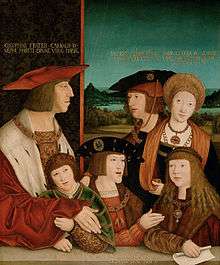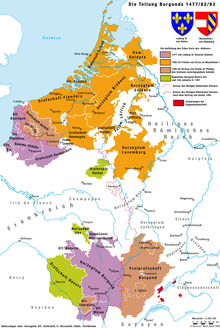Flemish revolts against Maximilian of Austria
In the period 1482–1492, the cities of the County of Flanders revolted twice against Archduke Maximilian of Austria, who ruled the county as regent for his son, Philip the Handsome. The revolts were rooted in the cities' desire to maintain the autonomy that they had wrested from Philip's mother and predecessor, Mary of Burgundy,[1] which Maximilian threatened to curtail. Both revolts were ultimately unsuccessful.

Background

At the end of the 15th century, Flanders was under Burgundian rule. When the Burgundian Duke Charles the Bold died in battle in 1477, his territories passed to his daughter, Mary. The Netherlandish towns and their States General compelled Mary to sign a treaty, the Great Privilege, that reversed some of the centralization of power undertaken by her father and her grandfather, Duke Philip the Good, and turned the Burgundian state in the Netherlands into a confederation of provinces.[2]:491 The Members (representatives) of Flanders obtained an additional Flemish Privilege, which required their consent in any constitutional change.[3]:439
Meanwhile, the area west of the Scheldt (Royal Flanders), as well as other provinces of the Burgundian state, were claimed as reverted fiefs by France. Fearing French invasion, the provinces of the Low Countries levied an army of 100,000 men to replace the former ducal army; more than one-third of its troops were supplied by Flanders.[3]:439 Mary, seeking peace with her powerful neighbor, was involved in negotiations with Louis XI concerning a possible marriage to the Dauphin Charles (then only eight years old), but her embassy met harsh demands for territorial concessions to the French crown.
On the evening of 16 August 1477, Mary instead married Maximilian of Habsburg, son of the Holy Roman Emperor Frederick III, at Ghent.[4] He would rule the Burgundian lands jointly with Mary, vowing to uphold the privileges granted to its towns and cities. The following years, a war with France was fought by Flemish armies under Maximilian, culminating in the 1479 Battle of Guinegate, a Habsburg victory. The German and other foreign troops were not well received in Flanders: the citizens of Ghent rioted against their presence in 1478.[3]:443
When Mary died in a horse-riding accident in 1482, her four-year-old son Philip the Fair in turn inherited her realms in the Netherlands, worsening the succession crisis in the Burgundian lands. By the terms of the Treaty of Arras (1482), Maximilian was forced to cede Artois and Picardy to France, but retained control over Flanders as Philip's guardian.[5][6] France nevertheless openly supported Flemish "particularism" against the Burgundians/Habsburgs.[2]:491
First revolt (1483 - 1485)
Several Flemish cities challenged Maximilian's guardianship of Philip, fearing centralization of power in the combined Habsburg lands.[5] Ghent was the Archduke's main opponent, and went so far as to issue its own coinage in Philip's name, an act that was "perilously near to a unilateral declaration of independence" because the unification of coinage was vital to the Burgundian Netherlands' prosperity.[7]:58 On 5 June 1483, the Flemish cities formed their own regency council for the young prince.[5]
Since Philip was in Bruges, in the hands of the rebels, Maximilian attempted to negotiate, offering to dismiss members of his court that displeased the Flemish.[7] Simultaneous troubles in the Prince-Bishoprics of Liège[lower-alpha 1] and Utrecht,[lower-alpha 2] meant that the archduke could not intervene until 1484.[8] His relationship with Flanders deteriorated as the Knights of the Golden Fleece at Dendermonde deposed him as head of their Order, Bruges refused to admit the archduke into their city with a company of more than a dozen people, and the commander of the Flemish armies proclaimed himself lieutenant-general in the name of Philip the Fair.[3]:446
Flanders attempted to forge an alliance with the neighboring Duchy of Brabant, but did not succeed.[3]:446 In November 1484, Maximilian convened the States General; Flanders did not attend, but the other provinces of the Burgundian Netherlands pledged their support to the archduke, enraged as they were by the Flemish cities' unwillingness to cooperate (in particular, Bruges and Ghent had attempted to block Antwerp's trade routes).[7]:61 Instead, the cities and nobility of Brabant ultimately joined the Habsburg side.[8] In France, Louis XI had died, and the new King Charles VIII was underage. His regency council withdrew its armies in spite of French promises to support the Flemish,[7]:61 but the French did appease the Flemish towns by renouncing the Parliament of Paris' claim of jurisdiction over them.[3]:446
1485 saw open warfare between the Habsburg prince and the Flemings. In January, Maximilian's army took Oudenaarde and subsequently defeated the forces of Ghent under their own walls. But when a mutiny broke out in his army, he was forced to retreat; French troops led by Crèvecœur then entered the city.[3]:446 The French, however, misbehaved so badly when in Flanders that they too were soon forced to leave for Tournai.[3]:446
The following summer, first Bruges and then Ghent saw a coup d'état in favor of Maximilian.[7]:61 On 21 June Bruges surrendered, acknowledging Maximilian I as its mambourg[lower-alpha 3] followed by a similar acknowledgment by Ghent a week later. Philip the Fair was returned to his father on July 6.[3]:446 The archduke made a treaty with Ghent and Bruges, confirming the cities' privileges, but soon revoked all these terms:[7]:61 on July 22, he enacted revenge on Ghent, had 33 rebel leaders executed, many more banished, and the city's privileges were to be reviewed and revised by a committee.[3]:446
Second revolt (1487 - 1492)
With the rebels in the Netherlands subdued, Maximilian again turned his attention to France and raised taxes in the rich Southern Netherlands to finance his military campaigns.[8] Compared to the period of Maximilian and Mary's joint reign, the taxes levied on Flanders had doubled by 1487, while the seigniorage on silver coins had risen to 120 groats per mark (effectively 12%), up from at most three groats under Philip the Good. Inflation grew rampant, with food prices rising, in some cases doubling; epidemics decimated the population.[7]:61–62 Economic hardship and heavy taxation, combined with the failure of the military campaign against France,[8] sparked a second revolt in Ghent in November 1487, led, like the previous time, by the weaver's guild.[7]:62 From Bruges, Maximilian, now King of the Romans, negotiated with Ghent the following month. But when he attempted to close off the city with his own troops in January the following year, the guilds of Bruges joined the revolt, demanding publicity of the grievances of the rebels (a.o., plundering of the country by Habsburg troops[7]:62) as well as the decision making process.[5] They forbade Maximilian from leaving the city, then in February imprisoned him after installing new municipal officials, loyal to Philip[1][5] and executed one of Maximilian's ministers.[6]
Both the papacy and the Holy Roman Empire intervened in the conflict. The pope excommunicated the rebels[lower-alpha 4] and Maximilian's father Frederick III, Holy Roman Emperor, raised an army of 20,000 men in Germany that reached Flanders through Brabant in April 1488.[7]:65 In the following month, Maximilian made a deal with his captors. He was to relinquish the title "count of Flanders", leaving control of the province in the hands of a government similar to the one that existed prior to 1482, in exchange for a yearly fee. But as soon as he had left the city, he broke the oath, citing his feudal oath to his overlord, his father the Emperor, as taking precedence over the oath he had just sworn.[7]:65
Maximilian's military commander Philip of Cleves had volunteered to take his lord's place as the rebels' hostage, but subsequently joined the rebellion for what he considered treason by Maximilian.[8] The former Admiral of the Netherlands became the rebels' military commander and "terrorised the sea" using Sluis as a naval base.[9] Brabantian cities including Brussels and Leuven joined the rebellion,[1] as did the Hook party in Holland.[8] Antwerp again chose the side of the Habsburgs, raising a mercenary army of ca. 1400 soldiers, including 400 cavalrymen.[1]:150
The second Flemish revolt was ultimately crushed in 1492 by Frederick III's army, now aided by the English. German blockades of Bruges' trade routes and ports, supported from the sea by a fleet led by the English Admiral Edward Poynings,[10] paralyzed the city's trade.[6] The Flemish cities were forced to accept Maximilian as regent.
Results

In the Treaty of Senlis (1493), the new French king, Charles VIII, ceded Artois and Saint-Pol and renounced his claims to Flanders. These territories became part of the Holy Roman Empire, of which Maximilian became emperor in August of the same year. The next year, 1494, he formally bestowed the government of the Low Countries upon Philip,[11] who proved popular with the nobles of the low countries.[2]:492 The larger part of Flanders remained in Habsburg hands until 1794.[lower-alpha 5]
One of the consequences of the revolts was the rise of Antwerp as an economic power, at the expense of Bruges. Antwerp (like Amsterdam) had lent support to Frederick III against the rebels[6] because of the many privileges it had received from Maximilian I,[8] and would see a "golden age" until the Dutch Revolt of the late 16th century.[12]
See also
- Austrian–Hungarian War (1477–88)
- Burgundian Netherlands
- Habsburg Netherlands
- Revolt of Ghent (1449–53)
Notes
- Following the murder of Louis de Bourbon, Bishop of Liège by William de La Marck.
- The Second Utrecht Civil War, involving the Burgundian bishop of Utrecht.
- Protector; A title previously awarded to the Dukes of Burgundy.[3]:422
- Via the archbishop of Cologne; Koenigsberger notes that the decree may have been forged.
- Except for Zeelandic Flanders. See Spanish Netherlands, Austrian Netherlands.
References
- Frederik Buylaert; Jan Van Camp; Bert Verwerft (2011). Anne Curry; Adrian R. Bell (eds.). "Urban Militias, Nobles and Mercenaries: The Organization of the Antwerp Army in the Flemish–Brabantine Revolt of the 1480s". Journal of Medieval Military History. IX.
- Pirenne, Henri (1909). "The Formation and Constitution of the Burgundian State (Fifteenth and Sixteenth Centuries)" (PDF). The American Historical Review. 14 (3): 477–502. doi:10.2307/1836443. JSTOR 1836443.
- Lord Acton; Adolphus William Ward; George Walter Prothero; et al., eds. (1902). The Cambridge Modern History. Volume I: The Renaissance. Cambridge University Press.
- Heimann, Heinz-Dieter (2004). Die Habsburger: Dynastie und Kaiserreiche. pp. 38–45. ISBN 3-406-44754-6.
- Jacoba Van Leeuwen (2006). "Balancing Tradition and Rites of Rebellion: The Ritual Transfer of Power in Bruges on 12 February 1488". Symbolic Communication in Late Medieval Towns. Leuven University Press. ISBN 9789058675224.
- Friedrich Schiller (1847). History of the Revolt of the Netherlands. Harper & Brothers. pp. 33–34.
- Koenigsberger, H. G. (2001). Monarchies, States Generals and Parliaments: The Netherlands in the Fifteenth and Sixteenth Centuries. Cambridge University Press. ISBN 978-0-521-80330-4.
- Bart Willems (1998). "Militaire organisatie en staatsvorming aan de vooravond van de Nieuwe Tijd. Een analyse van het conflict tussen Brabant en Maximiliaan van Oostenrijk (1488–1489)". Jaarboek voor middeleeuwse geschiedenis. 1. pp. 261–286.
- L. H. J. Sicking (2004). Neptune and the Netherlands: State, Economy, and War at Sea in the Renaissance. Brill. p. 129. ISBN 9004138501.
- Joseph B. M. Kervijn de Lettenhove (1867). Geschiedenis van Vlaanderen onder zijne graven en onder het huis van Burgondië. 2. Ghent: Van Doosselaere. p. 425.
- "Maximilian I". Encyclopædia Britannica Eleventh Edition. 1911.
- Patrick O'Brien (2001). Urban Achievement in Early Modern Europe. Cambridge University Press. p. 48. ISBN 978-0-521-59408-0.